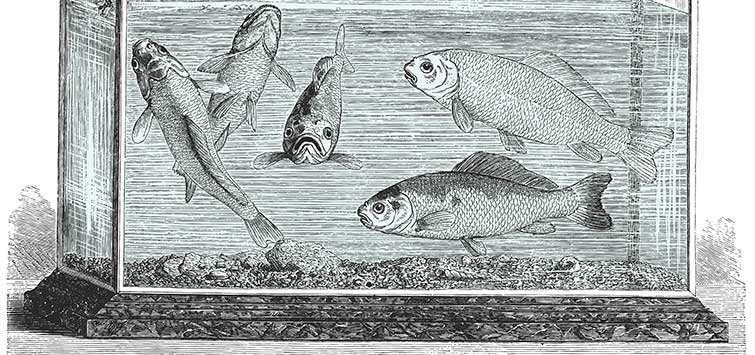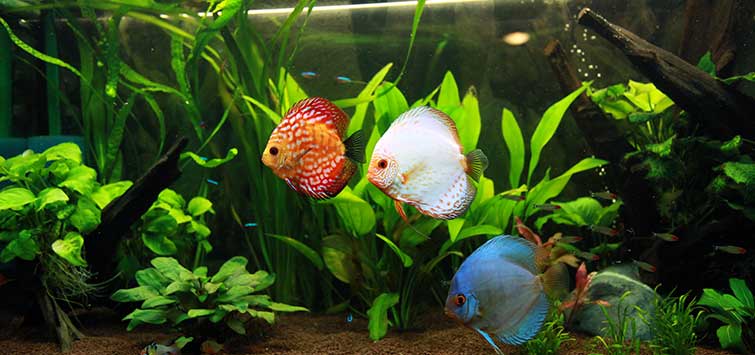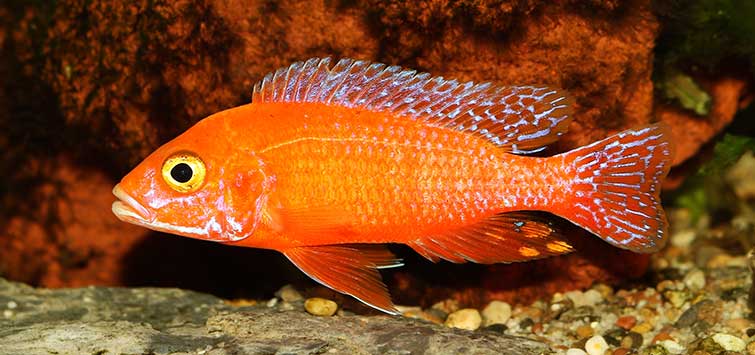The Making of an Aquarium --- 100 Years Ago
Author: Albert J. Klee, Ph.D
A glimpse into the late-Nineteenth-Century aquarium hobby as seen through the pages of a February 1899 Ladies’ Home Journal article on a do-it-yourself aquarium building project.
Traveling Back in Time
The aquarium literature of the Nineteenth Century has always had a special fascination for me since it provides a window into the aquarium world of over a hundred years ago. A good example is the February 1899 issue of The Ladies’ Home Journal containing an article entitled, “Making a Home Aquarium,” by J. Oliver Nugent. It might be thought that the frameless, all-glass aquarium was an invention of the 1970s. This, however, is a misconception, as this article shows.
The magazines of the day, like the newspapers, tended to be large, and The Ladies’ Home Journal was no exception, measuring a whopping 16 inches high and 11 inches wide, and containing 38 pages. Finding themselves in a surprise rain shower, a woman could open up such an issue and hold it over her head as a substitute umbrella affording protection even for those enormous hats of the period! The accompanying images show both the front and rear covers of this issue, the rear cover featuring a full page ad for a corset designed for the “Five Million Stout Women in America.” In this regard, perhaps things have not changed all that much. The ad reads in the fine print:
“Whom Nature has endowed with a superabundance of flesh, who are seeking a corset that affords all necessary support, and at the same time provides perfect comfort, should wear ROYAL WORCESTER CORSET, THE DOWAGER STYLE 550. A positive boon for fleshy women, and at a price within reach of all.” Advertisers of the day evidently didn’t mince words!
This particular issue contained several delightful articles including “Food for Men and Women Over Fifty,” “What it Means to be Engaged,” and, the article in question, “Making a Home Aquarium.” The article is quite detailed and has a few surprises. Most aquarists would assume that today’s all-glass frameless tank is relatively new on the aquarium scene, but the article actually describes the construction of a frameless tank, albeit using “crockery mender” en lieu of silicone. There were a number of adhesives that were sold (or made at home) under this name, and the article gives no indication as to the kind used. However, the following are two very common recipes taken verbatim from the book, Dr. Chase's Recipes; Or, Information for Everybody: An Invaluable Collection of About Eight Hundred Practical Recipes,” published by A. W. Chase, MD in 1864:
Extract 1:
Russian Cement
Much is said about cement; but there is probably nothing so white and clear, and certainly nothing better than the following: Russian-isinglass dissolved in pure soft water, snow water is best; for it takes 12 hours to soften it by soaking in pure soft water, then considerable heat to dissolve it; after which it is applicable to statuary, china, glass, alabaster, &c., &c.
In all cements the pieces must be secured until dry. It is easy to reason that if twelve to fifteen hours are required to soften this isinglass that no dish-washing, will ever effect (sic) it. You may judge from the price whether you get the Russian, for thirty-seven cents per ounce, is as low as the genuine article can be purchased in small quantities, whilst the common, bear a price of only from ten to twelve cents, and even less.
Note: Russian isinglass is a fish glue, but unlike ordinary fish glue, which is prepared from the waste products (heads, trimmings, and bones), Russian isinglass is prepared by using only the inner membrane of the air bladder of the sturgeon. The sevryuga (Acipenser stellatus) and the osËtr (A. gÜldenstÄdtii) yield the best Russian isinglass.
Extract 2:
Cement, Cheap And Valuable
A durable cement is made by burning oyster-shells and pulverizing the lime from them very fine; then mixing it with white of egg to a thick paste and applying it to the china or glass, and securing the pieces together until dry.
When it is dry, it takes a very long soaking for it to become soft again. I have lifted thirty pounds by the stem of a wine-glass which had been broken, and mended with this cement. Common lime will do, but it is not so good; either should be fresh burned, and only mix what is needed, for when once dry you cannot soften it.
It should be noted that although crockery cement could be subjected to water for fairly long periods without softening or dissolving (so mended crockery could be hand-washed), it could not withstand the long periods that would be experienced in the aquarium, and so the joints of the aquarium had to be isolated from water; this was the purpose of the white lead. The white lead used was generally a mixture of lead carbonate and lead hydroxide, ground into a fine powder and mixed with linseed oil. To protect the fish, therefore, the white lead was coated with an asphaltum varnish. Aquarists of the day had to be careful using white lead since it was also toxic to humans if inhaled or ingested.
The leatherette (originally a trademark, it was a covering fabric produced from a strong, machine-glazed base paper, which was coated and embossed, or printed and embossed, in imitation of grained leather) used to bind the corners of the aquarium mentioned in the article provided no significant support, as its purpose was primarily cosmetic to hide the asphaltum-covered white lead.
The plants of the days were native plants collected locally. The “mermaid weed” mentioned in the article below is Myriophyllum. The triton alluded to is one of the common aquatic salamanders or newts of the genus Triturus. Although not specifically identified, judging by the plants and other animals mentioned, the fish intended for this aquarium were undoubtedly native fishes or possibly goldfish.
An interesting aspect of the advice given concerns the feeding of crackers and raw beef. In reality, this is a fairly well-balanced diet that would have suited the omnivorous native fishes of the day quite well. The following is the complete article by Nugent.
Old Magazine Article:
Many people make the mistake of buying a globe in which to keep fish. This form of aquarium is not suitable for the purpose; it distorts every object placed in the water, and subjects a fish to a change of shape and size with every movement. A square or oblong tank is preferable. Any one wishing to build a tank should first decide upon the size; then get five pieces of glass, which, when put together, will form a box of the required dimensions. Plate glass from an eighth to a quarter of an inch in thickness is strong enough for any tank.
Measure the pane of glass to be used for the bottom, and obtain a piece of well-seasoned wood from one to two inches longer and wider than the measurement of glass, and about one inch and a half thick. Then buy ten cents’ worth of white lead and a bottle of some good crockery mender to use as cement. An eighth of a card of leatherette is needed to bind the corners. You will need, also, a piece of fine wire to go around the tank, and ten cents’ worth of asphaltum varnish.
Build the tank in the following manner: Place the piece of glass which is to be used as the bottom in the centre of a board, and mark the exact size of glass on the board. Stand the sides upright, care being taken to hold them perfectly still, and run the pencil closely around the outside of them; then with a rule carry the lines out to the edge of the board. Saw a groove between the lines about half an inch deep. Smear the under side of the bottom piece of glass with crockery cement and place in position on the board as shown in Figure 1.
Lay a heavy weight upon it for five minutes. During this process take enough white lead to fill the grooves and fasten the corners. Pour in a little crockery cement and mix thoroughly. Smear with pure crockery cement the edges of the glass already fixed to the board, gently, so as not to move it. Fill the grooves with the mixture of white lead and cement; smear the bottom and the two end edges of each side piece with crockery cement and press them into the grooves, as illustrated in Figure 1.
Tie a piece of strong twine around the outside to keep the corners close together, and measure the depth of the tank on the inside and cut four strips of leatherette, an inch in width, the exact length. Crease them in the centre, allowing the right side to face in. Give them a coating of white-lead mixture, and place them on all of the corners. Figure 2 shows the glass sides in position.
Cut four more strips about an inch longer. Crease with the right side out, then take off the twine, coat strips with lead mixture, and place them on the outside of the corners. Figure 3 shows the tape on inside corners.
Cut a V-shaped piece in the upper end, and turn the ends over so as to end on the inside. Hold tightly in place. Figure 4 shows the tape on outside corners.
Now wind a piece of fine wire about the outside and cover this with a strip of leatherette. Run along the seams at the bottom of the tank inside and outside with some of the white-lead mixture, and allow it to dry for at least three days. Figure 5 shows the tank with all of the corners bound.
After making sure that the white lead is thoroughly dry, clean the corner strips and glass. Next give the corners, seams and board a coating of asphaltum varnish. This must be most carefully done, as white lead is poisonous to the fish. Figure 6 represents the tank when it is entirely finished.
It is always a good rule to fill the tank with water after it has been varnished, and let it stand over night, to remove any free particles of dust, etc. Plenty of work will be found to do while your tank is drying—collecting sand, building arches, and making a net with which to catch specimens of fish.
A good net may be made by taking a piece of stout wire, forming a loop by twisting one end, running thy other end into a stick, and sewing a piece of mosquito netting to the wire. The sand and pebbles for the aquarium may he collected from the bed of a stream. The arches may be built of any kind of rock and pebbles stuck together with cement.
Any plant which grows in streams or ponds, or upon their margin, is suitable for the aquarium. One of the most decorative is Mermaid weed. Tapegrass may be found in any slow-running stream.
The little Bladderwort may be known by its cluster of yellow flowers. Willow moss is extremely useful. The Hornwort is decorative. Pond weed makes a resting place for the insects. Nitella may be found at the bottom of ponds. There are eight kinds of Sagittaria found in this country; of these Sagittaria natans is the most satisfactory for the aquarium.
When the tank is thoroughly clean and dry you may prepare the bed of your aquarium. The sand, thoroughly cleaned, should be distributed evenly upon the bottom of the tank to the depth of two inches or so. Over this strew a layer of pebbles, and place your arches and plants in position. If you find that the plants are insecure a small quantity of clay should be fastened to their roots, besides weighting them with pebbles. Then pour in the water. Never use boiled water.
While filling, place our left hand, palm up, near the sand, and pour the water gently over your palm, so that it will trickle down without disturbing the roots or washing up the sand. Keep your hand just above the water and gradually fill the tank to within two or three inches of the top. A piece of thin, smooth wood should now be used to disengage and float out in a natural way the foliage of the various plants. The water in the tank will evaporate according to the temperature; when it evaporates an inch add an equal amount of water. If rightly stocked with animal and plant life it is seldom or never necessary to change the water.
Before putting in the fish, drop in a few common pond snails and tadpoles. These will consume the decaying vegetation.
As the tritons feed upon the minute parasitical insects that injure aquatic plants they are really useful in the aquarium. The frog is a relative of the triton, and, in a tadpole state, the two cannot easily he distinguished; as they grow, however, the difference is apparent. Among insects, the boatfly is worth having. You will find him in any stagnant pond. The margined beetle is also quite useful.
The animals and fish should be fed at a certain hour every day with a few small pieces of cracker. Once a week a small piece of raw beef impaled on a straw should be given to each. If the beef is dropped into the water there is always the danger that one or more greedy fellows will seize it all.
Back to the Future
The evolution of glass used for aquariums spans an astonishing period of nineteen centuries, with the last two and a half centuries being the most dramatic and momentous. Whereas the glass of yesteryear suffered from distortion and lack of clarity, today’s glass is, as they say, “picture perfect.” Changes in the manufacturing process not only produced better glass, but cheaper glass as well. In conjunction with improvements in sealants, the aquarist of today is able to produce aquarium designs that, in their own way, rival the development in the past fifty years of computers, television, and space travel.

.png?h=595&iar=0&w=2781&hash=5FD5E69473BCC22199FBFA2FB71B6033)



